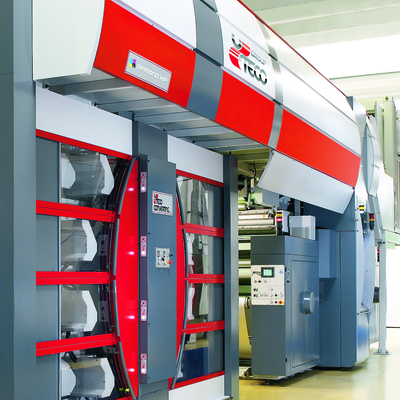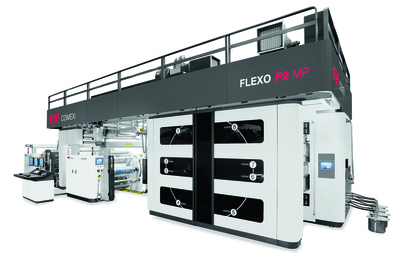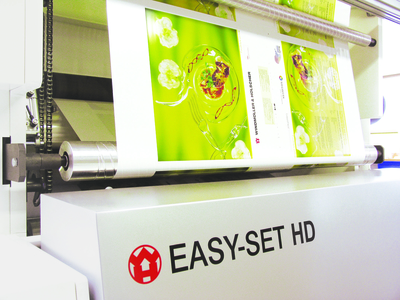The Easy-Set HD module from Windmöller & Hölscher
Automating the various processes on flexo printing presses is nowhere more in evidence than on wide web machines, be they central impression or sheetfed. By Neel Madsen.
With run lengths getting shorter, demands for highest quality increasing and the need for cutting waste to a minimum seen as essential, wide web flexo presses must perform to tight tolerances and offer exceptional, repeatable results every time.
‘Nowadays, one of the biggest improvements we can find in the machine technologies are those related with the process of the start up of the job, on how to adjust the correct pressure, register and colour. Those processes, if they are not under strict control, can have a significant impact on the result both in terms of the quality of the job and the cost,’ said Jordi Puig, Comexi’s flexo technical manager.
As easy as …
Windmöller & Hölscher’s Easy modules were first introduced in 2004 with new upgrades and versions added since. Easy-Set HD for automatic print cylinder and anilox roller positioning is based on full (100%) image analysis using a high resolution line camera. Easy-Reg for automatic register set up has been designed as a supplement to Easy-Set HD, and utilises the same line camera to analyse the printed image and bring the individual colour decks into accurate register, while Easy-Col performs automatic ink matching on the press.
These systems have become significant success factors for its customers worldwide. Having purchased its first W&H press about seven years ago, Columbia-based Plastilene, which runs another production location in Guatemala, was one of the pioneers paving the way for Windmöller & Hölscher in South America. The investment in a Primaflex CM 8 was succeeded by a Novoflex CM 8 and several Miraflex AM presses for the Bogota site, with another Miraflex AM 8 for the production location in Guatemala. The company has seen dramatic reductions in changeover times and waste through the consistent use of the Easy modules installed on its presses, a trend confirmed by several other South American customers.
Just a kiss
Initially developed in conjunction with Grafikontrol for its Onyx CI press, Uteco’s whole range of presses now features the successful Touch&Go, Kiss&Go and Click&Drag systems for automatic impression setting and register with minimum start up waste created (average waste is 12 metres per printing unit).
The system consists of a compact scanning unit, which is installed immediately after the last printing station on the central drum, and by a main processing unit with a touchscreen interface for operator control. The patented system performs an optical scan of the printed area to calculate the correct printing impression settings and transfers any corrections to the printing deck positioning system. The optical scanner is a contrast sensor, which registers the quantity of ink laid down on the substrate independently of the printed image. Web tension is controlled via the SynchroWeb software, which uses PID control loops to obtain the tightest print register accuracy.
The parameters are fed into the ShopWare press control system, which provides a full overview of the press settings and print specifications in real time. A modem is integrated into all Uteco presses to allow for remote troubleshooting by the service department.
Mastering the boards
The Masterflex-HD press for flexo post-print from Bobst features an automated register setting system called Start&Go, which works by reading printed marks on the sheet and using the information to control and bring into register each print unit at start up, and throughout production. The system will adjust print length, skew, and both transverse and longitudinal register without the need for operator intervention.
The company introduced the iQ300 quality control system in 2010 to enable printers to meet the quality standards set by the customer, while simultaneously cutting setting times and reducing waste. The system detects a wide range of print defects and can be used on board ranging from microflute to double wall, in sizes up to 1300 x 2100 mm, and on presses running at speeds of up to 12,000 sheets per hour. Sheets containing elements identified as defective are automatically ejected, flagged up or ignored by the press, according to the settings defined and the level of quality chosen by the operator. This can also be retrofitted to older presses, and works hand in hand with the Registron S5500 system, adjusting the machine as necessary to achieve perfect results every time.
 Uteco Diamond HP press
Uteco Diamond HP press
Sensing the colour
Flexotecnica is due to release a new on press, real time, spectral colour measurement system, which together with high performance 100% video inspection, offers standardised consistent print quality and significant reduction of start up waste minimising the need for human intervention at press stops.
The system comprises a spectral sensor, video cameras with lighting and software to process the image. A central data unit enables viewing of print defect information, registration, spectral data L*a*b* and ΔE at maximum production speed. It can exchange data with ink formulation software, with colour and density deviations relayed via CxF file resulting in automatic ink recipe changes.
‘In our highly competitive packaging industry, modern inline spectophotometric integrated colour measurement is gradually becoming an essential factor where getting good print results first time with minimised waste and downtime is important,’ said sales manager, Tim Hilton.
For automated impression and register settings, the company has the AIF and ARF systems available on its EvoXG and EvoXD range of presses. The AIF system enables automatic control of print impression positions with or without the use of dedicated marks. It combines with the ARF system for automated registration, and both systems are controlled via an operator touchscreen interface.
Soaring above
Falcon II is the second generation of automation technology from Soma Engineering and it consists of two processes designated Automatic Impression Setting and Smart Register system by BST International. The automatic impression setting determines the printing pressure at the start of a job without the need for dedicated print marks.
The system reduces waste at start up by as much as 70% and makeready times by up to 50% allowing both long and short printing runs to be processed economically and with significantly improved profit margins. Impression and register for a 10 colour job can be reduced to a 45 metres.
‘The BST Smart Register system is well proven software to assist the operator to set accurate registration points,’ said sales director, Pavla Kusa. ‘The operator starts the press and stops the machine to check registration after a complete image is printed. The settings are then adjusted with the assistance of intelligent software by matching the individual printing points, colour after colour to the registration mark parameters. Intelligent software and servo assisted drives then automatically move the printing sleeves to the correct position according to the pre-set values. This means the operator can accurately set the register for every printing deck resulting in less waste, faster make ready, increased available press time and improved print quality. It is a modular system that can be applied to any Soma press with any repeat range and can also be retro fitted to existing machines.’
Singular solution
Comexi has developed the new CingularReal solution for automated pressure and register. The solution works by comparing the printed image to a digital master file. When carrying out the register adjustment the image is processed digitally and compared to a PDF file using real-time image processing algorithm.
Mr Puig explained, ‘The key point in selecting a system that helps reducing the waste in the process of adjusting a new job is the reliability of the adjustment, ie how close the automatic adjustment is to the adjustment carried out by a skilled operator manually. In other words, it is about not only reducing the waste, but that the adjustment is correct (that means, for example, the pressure adjustment with an overpressure not exceeding 30 to 40 microns) and works the same each time.’
He continued, ‘Printing is the only way to see the real impact of all the parameters. This takes us to consider that the most reliable adjusting systems are the so-called ‘Real Adjustments’ solutions.’
The new Comexi system offers time savings and reduction in waste when checking the approved artwork and analysing the impression setting on the substrate without the need for dedicated marks on the printing plate. It is available on the company’s range of Flexo F2 presses.
Ink automation
Systems to regulate the ink flow, match colours, formulate and dispense the ink, to provide maximum efficiency and reliability can also be found on wide web presses.
Soma Engineering’s new InkFlow and InkStorm inking and washing systems use a new pump design that features higher volume, large diameter membranes with low suction to reduce wear and increase component life. These are optimised for reliability and trouble free operation.
The integration of the inking and washing components permit gentle and constant ink circulation through the whole system with only the required amount of ink is drawn from the ink container and delivered to the doctor blade chamber. InkFlow is also equipped with pressure stabilisation that permits a stable flow of ink to be delivered to eliminate surges and avoid any ink loss through too much pressure or mis-adjustment. InkStorm incorporates new software to assist wash up and offers several new functions. The operator can choose between three different washing cycles, short, medium or intensive, depending on the requirements of the individual printing deck.
 The Flexo F2 press from Comexi
The Flexo F2 press from Comexi
The company has also developed its own InkFix system used to mix tints of direct inks for in order to speed up introduction of a printing job. This colour matching system is relatively simple and consists of a digital scale operating with precision of ± 1 g, a device for colour tint measuring, ie L*a*b* values which can be either a manual spectrophotometer, such as SpectroEye supplied by X-Rite, or an automatic inline spectrometer, such as SpectralCam from QuadTech, Ink formulation Printer Pro recipe software supplied by X-Rite and a system for ink mixing. This can be either the semi-automatic InkFix mixing unit produced by Soma or an automatic mixing system supplied by Inkmaker.
Great success
Windmöller & Hölscher has sold over 100 of its Easy-Col colour matching systems worldwide. The company estimates that without this module available, up to 50% of the time it takes to set up the press for a new job will be spent on colour matching alone. Easy-Col reduces the time needed for precisely setting the colour values, while at the same time minimising residual ink through inline recording of the current ink use.
At JG Service AG, in Germany, the module is in daily use. ‘Since the commissioning of our Miraflex press with Easy-Col, the use of this module by all our printers has resulted in absolutely consistent colour matching results, which means that no more than one or two colour matching cycles are now needed to achieve the specified colour values, resulting in significant savings in regard to waste, time and residual inks,’ said plant production manager, Ernst Schönacher.
Beat Franceschini, the CEO of PetroplastVinora, in Switzerland, agreed, ‘The Miraflex CM 8 and an order-oriented press equipment, including Easy-Col, will give us a competitive edge in the long term.’
Oleg Ushakov, technical director of OOO ALFA Flex Print, in Moscow, said, ‘Reliable and reproducible colour matches, independent of the operator’s skill and form on the day, are essential to quickly get to the desired shade with a deviation from the artwork copy of maximum ∆E=2. The Easy-Col module has notably eased and optimised our production.’
In the kitchen
Uteco has the SmartMatch solution for colour matching and ink formulation. The software links a spectrophotometer to the SmartKitch, a mobile dispensing unit, which is linked to the press. It works by reading the image reference and transferring the data to the mobile unit, which then prepares the correct colour formulation and exact amount of ink needed. Reports of usage and formulations are kept in the system for complete traceability and cost control.
For optimal wash up of the printing units, SprintWash is an automatic, modular washing system that features three different wash cycles (light, medium and heavy). The operator can specify the need of each unit individually.






